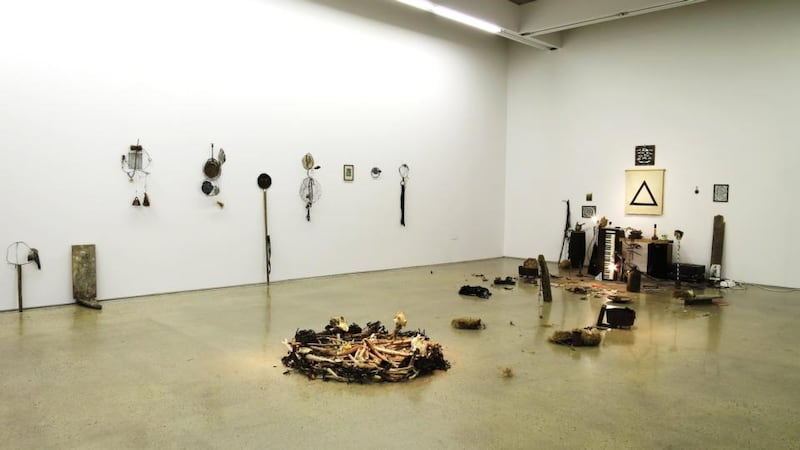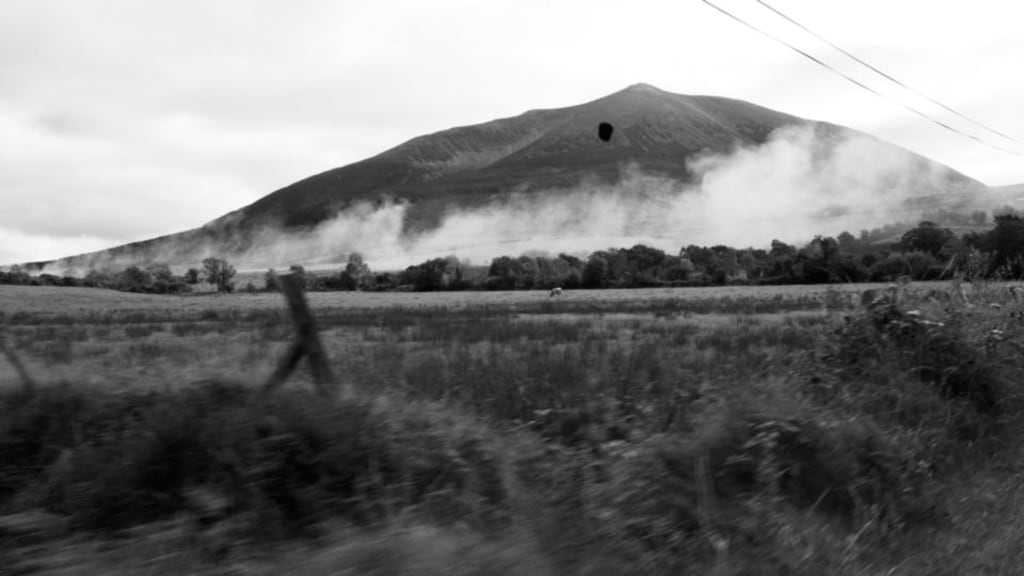Niamh O’Malley;
Mairéad O’hEocha: Paintings
Douglas Hyde Gallery, Dublin

****
The Douglas Hyde isn’t your average White Cube gallery. In fact, its singular architectural character makes it a challenge for any artist who takes it on. And it doesn’t stop there. Apparently you don’t have the option of cancelling out the space by dimming the lights and blocking out the natural light, something that’s likely to have been an issue for Niamh O’Malley, much of whose work has featured projected imagery in darkened spaces.
The two film pieces in her current solo show are screened on monitors, and, like the rest of the sculptural and graphic works on display, are quite small in scale. The whole exhibition amounts to the most tactful, even tentative of intrusions into the gallery's brutalist fabric that you can imagine. Furthermore, all of the work draws us in close. It's muted, textural and monochromatic. Which is fine, although one is left with the lingering feeling that it would have been interesting to see the central work, Nephin, projected on a large scale, as was the case with her earlier, hypnotically watchable Island, filmed around the pilgrimage site of St Patrick's Purgatory on Lough Derg.
As with Island, Nephin suggests a ritualised, circular process, another pilgrimage of sorts. The premise is simple: we see the isolated north Mayo mountain in the distance from within a moving car, which gradually makes its way around it, taking in aspects of rural, farming detail in the foreground. We never approach the peak, and a contrived blind spot disrupts any possibility of getting a clear grasp of it, but the camera is trained on it throughout, so it's there as a constant, brooding, slightly disquieting presence. The way that it was, presumably, for O'Malley, who grew up within sight of it.
Presence at a distance – or presence rendered inaccessible and questionable – are hallmarks of her work to date. The other film work, Glasshouse, emphasises this. Its two adjoining screens feature an endless tracking shot from the inside of a greenhouse. We are looking out through supposedly transparent panes, but it's as if we are looking from one world into another. It's more or less impossible to see anything. Details hint at coherence but never add up to anything. We live, O'Malley implies, in a representation. We may like to think that our own view is true and authentic, but like the mountain forever there at the fringes of our vision but unknown and unexplored, the real thing eludes us.
In Gallery 2, four paintings by Mairéad O'hEocha follow on from her well-received 2011 exhibition in the main gallery, Via an Lár. They demonstrate that she hasn't settled into the consolidation of a popular style. Go back four or five years and her work could seem a little too neat: smart, technically accomplished but on the verge of becoming mannerised.
Her subject matter was rich: the semiotically jumbled, hybridised landscape – urban-rural, new-old, real-fake – produced by the development of the road network in Ireland’s southeast.
These recent paintings are edgier, livelier and more technically demanding, as though she has challenged herself. She handles paint with greater freedom and avoids stylistic mannerisms. She has introduced a much broader palette, which she manages with impressive elan, giving a musical vibrancy to each composition.
There's usually a naturalistic rationale underlying the colour – falling raindrops touched by neon light, for example – but she extends it inventively. She still addresses the hybrid worlds we create by a mixture of design and accident and persuasively implies that even the most familiar places are actually pretty strange. Until February 25th, douglashydegallery.com
Richard Profitt: Wild Cries of Ha-Ha
Kevin Kavanagh Gallery, Dublin
****
Visit Richard Proffitt’s show – and you really should – and it’s as if you’ve stumbled on to the residue of some arcane cult gathering, recently abandoned. His atmospheric installations typically incorporate assemblages of emblematic objects and materials. They might include rough wooden constructions, driftwood, fragments of animal skeletons, feathers, beads, candles, coloured light bulbs, old watches or clocks, portable cassette machines playing incantatory, repetitive music, incense, fabric fragments, figurines, badges, hand-drawn symbols, printed texts and anomalous bits and pieces – many singed by fire.
Hallucinogenic substances could well be involved, you feel, in whatever rites were going on. There’s a curious mixture of fussy precision and chaotic, even deranged DIY to the way things are assembled and ordered. You’re catapulted into the obsessive mind of a devotee, someone possessed and transported, or perhaps a seeker desperate to believe.
Profitt draws on ancient belief systems and much more recent countercultural variations. He doesn’t parody or condescend. And there’s an anarchic, political dimension as well as a mystical one. It could be that he’s attracted to the weird, psychic energy bound up in these bold attempts to find alternative paths and whatever the aftermath, it’s a genuine energy, full of potential and possibility.
In his informative essay, Michael Hill points out that the show's title, Wild Cries of Ha-Ha, is an approximate translation of the name of one of the "charnel grounds described in Hindu and Buddhist spiritual texts". Living and dead commune in these highly charged places. Only a spiritual elite can be comfortable there. Equally, Hill elaborates, Proffitt emphasises the mundane nature of what is involved, the "ordinary scraps of discarded junk" that become "tools of divination and magic". That sounds a lot like art. kevinkavanagh.ie











